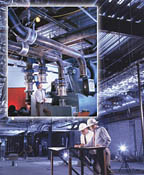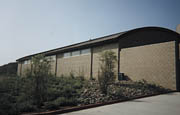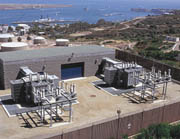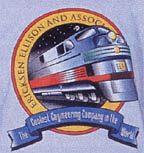
Issue: 12/01
PM Engineer is proud to announce that Bechard Long & Associates has been named the PME Engineering Firm of the Year for 2001. Located in San Diego, BLA has been providing Southern California with design consultant services on a variety of mechanical or electrical projects for 13 years. The firm provides design services for new and existing facilities to architects, facility owners, public agencies and developers for projects with specialized needs in hvac, power and lighting, plumbing, controls and instrumentation, and energy engineering, as well as providing assessments, feasibility studies, master planning and economic analysis. The facilities that BLA specializes in include laboratories, hospitals and central plants.
Although we received a number of highly qualified entries, BLA was chosen as the firm that best epitomized the six criteria established for the award: innovation in design, ability to meet schedules, completeness and thoroughness, industry involvement, community involvement and customer satisfaction.

Company History
Bruce Bechard, P.E., president of BLA, started the company in 1988 under the name Bechard & Associates, an engineering firm with one client (the University of California, San Diego) and a mission: "To be the engineers of choice for each project, providing leadership, innovation and responsiveness." In order to fulfill that mission, Bechard added an electrical engineering division and brought in Matthew Long, P.E., in 1993 to manage it. Long was made a partner shortly thereafter, and the name of the firm was changed to Bechard Long & Associates. The firm's third principle partner, Alan Wilson, P.E., joined BLA in 1995 to provide management for the firm's mechanical engineering projects. He was made a partner in 1999. Today, 13 years since its founding, BLA's client list has certainly grown, but Bechard is proud to say UCSD is still one of its most satisfied customers.
The company currently employs over 50 people, including nine registered professional mechanical engineers and two registered professional electrical engineers. A majority of the projects BLA is involved with include a large mechanical and electrical component, and typically involve renovation or upgrade of an existing facility. In these projects, the firm takes on the role of the "prime design consultant," providing engineering services for planning, evaluation of options, preparation of construction documents, plan check review and coordination of subcontractors, such as architects, civil and structural engineers, etc.

Innovation in Design
BLA has worked on several innovative projects over the years, Bechard said, a number of which have been completed for Southern California's various universities.California State Polytechnic University, Pomona, CA: One such project involved the installation of a district cooling system on the campus of California State Polytechnic University in the summer of 2000. As part of this $12 million project, 11 of the campus' buildings were converted to district cooling, so their old chillers, cooling towers and controls had to be removed and a central cooling plant installed. The challenge facing BLA was running 2 1/2 miles of 24-inch insulated water pipe underground to connect the central plant to the 11 buildings serviced by the system, while avoiding the campus's underground utilities and preserving its streets and landscaping. According to Bechard, BLA's engineers worked closely with the contractor on the project to develop a "slow concept"-digging a 12-ft.-wide, 8-ft.-deep trench through the campus without knowing exactly where the utilities were buried. The concept involved testing for buried utilities as the contractor slowly excavated the trench. Bechard was proud to say that the project was completed successfully and without any change orders.
Another benefit of BLA's design for the Cal Poly Pomona project was a substantial energy savings for both the University and the city of Pomona. This was made possible by eliminating the 11 individual chiller plants with poor energy efficiency and replacing them with one central cooling plant that offered high efficiency through the use of more efficient chillers and pumps, plus a thermal energy storage tank.
The new central cooling plant features three 1,250-ton Trane centrifugal water-cooled chillers and a one-million-gallon thermal energy storage tank, which can store 300 million Btus of chilled water, equal to 25,000 ton-hours of energy. The plan BLA came up with involved running the central chillers at night and storing the energy in the thermal storage tank until it was needed to cool the buildings during the daytime hours, when the chillers were turned off. Not only did this plan lower the amount of energy the University used, but it also decreased the drain on the city's power company, Southern California Edison, during daytime peak demand hours, thereby aiding the city during the recent utility crises.
University of California, San Diego: Another example of the firm's innovative design solutions could be found in a project for the University of California, San Diego. The $7 million project included expanding the cooling capacity at UCSD's central plant by 4,000 tons, adding two cooling tower cells at 12,000 gpm each to the cooling tower system, providing an 18-inch extension of the chilled water distribution loop, adding a 1,750 kW emergency generator and upgrading the emergency power distribution system.
The challenges for BLA on this project included coming up with a way to install the new piping, along with 4,000 tons of cooling, in the existing plant packed full of equipment. Bechard said that the engineers on this project found a way to make enough room to install the new pipe and chillers by relocating some of the electrical equipment, as well as a mezzanine storage area that would've been directly above the big chillers.
The biggest surprise came when BLA's engineers evaluated the condenser water system. The pumps in the existing condenser water system were way oversized, having been selected for an excess of pressure that the system didn't require. The original system contained 10 pumps at 250 hp each. By reselecting the existing pumps from 140 feet of head to 100 feet of head, BLA engineers reduced the pump motor size from 250 hp to 150 hp, cutting out 1,000 unnecessary horsepower. This made the pumps much more efficient and saved the university $300,000 a year in operating power costs, Bechard said.
Mercy Hospital and Medical Center, San Diego: On a project for San Diego's Mercy Hospital and Medical Center, BLA provided a feasibility study, conceptual design and preparation of construction documents to replace the existing chillers and boilers. The project included the replacement of four 250-ton electric chillers and one 200-ton steam absorber with three 300-ton electric chillers and one 300-ton steam absorber. One of the challenges the firm faced involved the redesign of the piping for the system. "We had to hot tap the major pipe headers feeding the hospital to install the chillers and still keep the hospital operating," Bechard said. "We used hot taps on 18-inch headers to weld new takeoffs with valves on them to connect the new chillers. It was a big challenge, but we got it done successfully."
R.W. Johnson Pharmaceutical Research Institute, La Jolla, CA: Another big project for BLA was working with the R.W. Johnson Pharmaceutical Research Institute (PRI) division of Ortho McNeil Pharmaceutical, Inc., a Johnson & Johnson company. PRI wanted an energy-efficient, environmentally friendly research laboratory designed, and BLA's engineering team used advanced computer modeling and system sizing to design the building envelope and mechanical and electrical systems that incorporated the latest energy efficient and environmentally friendly technologies. The engineers came up with a design using a unique condensate recovery system with the air handling units that would provide a positive impact on the environment. This system collects the condensate water that would normally be dumped down the drain and recycles it for use as makeup water in the cooling towers. Thanks to energy-efficient measures such as this, the project was expected to yield ongoing savings of approximately $535,700 a year. "Our A/E team collaborated early and often with the Johnson & Johnson engineering group to assure that the building systems would be designed for the long term, not just the short-term budget," Alan Wilson said in an article on the project.

Ability to Meet Schedules
When asked about BLA's ability to meet schedules consistently, Bechard said, "We don't miss schedules. We manage our projects and project managers effectively to get things done on time."Schedule is the most important thing next to quality control for BLA's team, according to Bechard. He explained that to meet schedules, his team takes a proactive approach when dealing with customers. "We don't wait for the customer to come to us with problems; we anticipate what those problems will be, and we come to them with multiple solutions," he said.
To do this, Bechard said, the BLA team has to interface with a lot of people on each project, so the engineering team will participate in round table discussions and planning meetings with utility companies, architects and contractors to find out where the problem areas are going to arise, and to work out solutions that will keep things under control.
BLA relies on its project managers to keep projects on schedule as well, Bechard said. "They focus on leading the design, as opposed to waiting to be led," he said, noting that at BLA, it is the duty of the project manager to help anticipate problems that will come up and to encourage the team to find solutions ahead of time.
Completeness and Thoroughness
According to Bechard, quality control throughout the project design is the key to ensuring that all of BLA's projects are completed correctly and to the customer's satisfaction. "We don't expect that when a project is done, we hand it to the quality control engineer, and he reviews it, and we're done," Bechard said. "We consider quality control from start to finish and from top to bottom. This includes the drafters, the designers and the project managers."
Each department has a quality control checklist to follow as well, Bechard noted. For example, he said, the drafting team has to make sure that their responsibilities have all been met, that the drawings are all consistent, the letter fonts are consistent, the arrows and bullets all point to the right things, etc. The drafting manager leads the team through the process, but each member takes responsibility for the quality control checks that their department must meet, he said. "The project manager checks the bigger issues--that loads and capacities are correct, the customer is getting what he wants--but the team doesn't expect that the senior guy is going to check every little thing at the end, because then it's too late," Bechard noted.

Industry Involvement
Several of BLA's employees are involved with associations in the industry. David Chin, P.E., head of BLA's plumbing department, is the president of the American Society of Plumbing Engineers (ASPE). Principle Alan Wilson is involved locally with the American Society of Heating, Refrigerating and Airconditioning Engineers (ASHRAE) as a member of its Board of Directors, and he is also head of ASHRAE's golf committee. And Wilson is a member of the International Society of Pharmaceutical Engineers. Bruce Bechard is involved with the U.S. Green Building Council, an organization that designs and promotes environmentally sensitive building technologies, such as buildings that use recycled materials and are energy efficient. He is also active with the local chapter of the Association of Energy Engineers (AEE), as well as local organizations in the San Diego construction industry, such as the Citizens Coordinate of Century 3 (CCC3) and The Downtown Partnership. Both of these groups are involved with redeveloping the downtown San Diego community, as well as encouraging new construction in the area. The firm is also involved with Christian Executive Offices, a group that promotes Christian values in business, taking part each year in CEO's annual National Day of Prayer event.
BLA also encourages students at the local high schools and colleges to consider engineering as a career. One high school program involves bringing a student in to the BLA offices to "shadow" an individual in that student's chosen field for a day to get a feel for the job. Another opportunity BLA supports is offered by one of the local colleges, which organizes a business forum that puts its students in touch with business people in their chosen field to discuss the industry. The firm also offers internships to encourage engineering students at the college level to join the building trades.
Community Involvement
Each year, BLA participates in helping Father Joe Carroll of St. Vincent de Paul Village send homeless children to summer camp by accepting donations from its employees and matching the contributions. This year alone, employee donations of $900 were collected, and with matching funds from the company, a total of $1,896 was donated to the fund. The money went not only to provide the camp activities, but also the food and outfits necessary for the children to participate. Most importantly, while the children were away, the parents were given time to take care of themselves and participate in their own programs, such as job training, counseling, parent education classes, chemical dependency programs or earning their high school diplomas.
The company also offers its services each year to "Christmas in April," a non-profit organization that performs complete renovations of dwellings that are in extreme need of repair for individuals with disabilities, senior citizens, needy families or community groups in low income areas. They accomplish this by coordinating the efforts of novice volunteers, contractors, vendors, etc., to paint, landscape, demolish, construct and rebuild homes. They also solicit sponsorships and product donations, and all the work is provided free of charge to the recipients. The employees of BLA volunteer their time during this event each year to provide the labor and materials needed to fix up one of these project houses. "Everybody gets a lot of satisfaction from helping the community, but it's a great social time as well," Bechard noted.

Customer Satisfaction
Bechard attributes BLA's successful customer relationships with the firm's ability to create innovative designs, offer cost-effective pricing and complete projects on time. "We've kept our mission and our original client by providing consistently high quality services on both large and small projects...We utilize tools that help us deliver the best possible product on time and at a competitive price," a company release stated.BLA's customers appreciate that concern for cost and energy savings. Regarding the Cal Poly Pomona project, Harmick Marcarian, associate director of the facilities management department, reported, "We've had no complaints from users, and we're saving a lot of money on the utility bill."
John Mohn III, P.E., PRI project manager for Johnson & Johnson, praised BLA's technology and search for innovative designs. "BLA used sophisticated computer modeling and system sizing for the building envelope and mechanical and electrical systems. It helped us to examine the benefits and life-cycle costs of the different energy-effective technologies," Mohn said.
The firm was also awarded a Certificate of Appreciation from the Southwest Division of the Department of the Navy for work their work on the renovation of a substation serving Point Loma Naval Facilities in San Diego.
